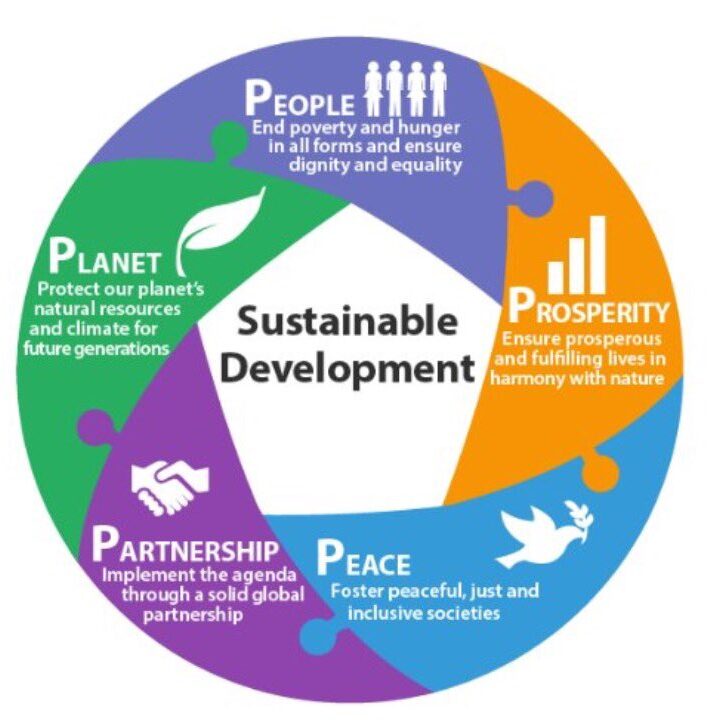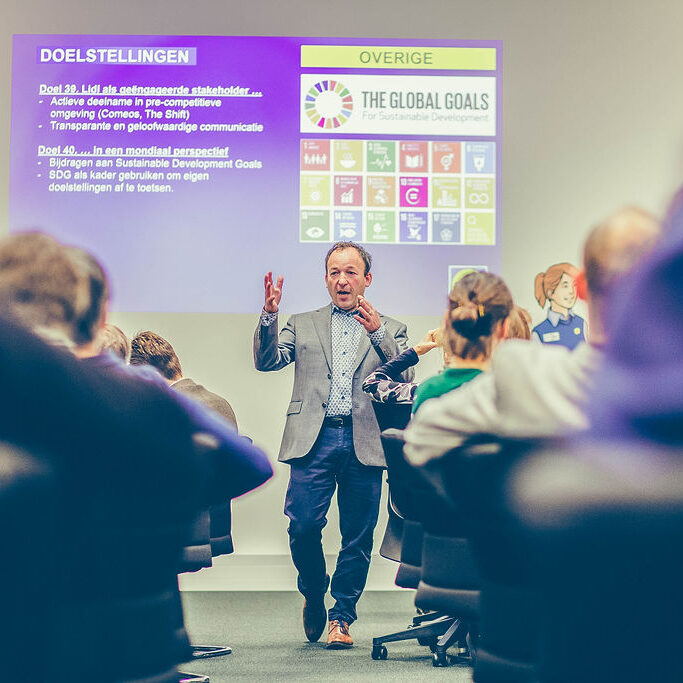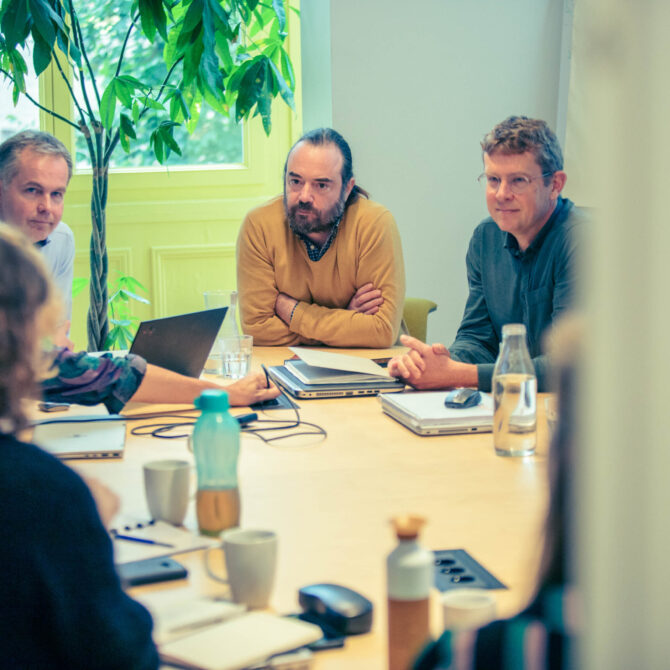Since their conception in 2015, the Sustainable Development Goals (SDGs) have offered companies and organisations a useful lens for looking at the sustainable impact of their own activities, inviting them to think about ways to positively contribute to society.
But how can you start applying the SDGs to your company? Which ones should you focus on? And which actions should you undertake per Goal?
At Sustenuto, we frequently get asked to support the SDG implementation in a company’s business or CSR strategy. In this article, we’ll explain the different steps to follow and provide some valuable tools to help integrate SDGs in your organisation.
Quick recap’: the Sustainable Development Goals

Since 2015, the UN Sustainable Development Goals count as a global denominator to work together for a more sustainable society. To this day, the 17 Goals to achieve by 2030 remain ambitious and ground-breaking, calling governments, businesses, NGOs, civil societies, and citizens alike to help build a liveable and futureproof planet with equal opportunities for all.
The SDGs have five pillars, building on John Elkington’s 3 Ps – people, planet, and prosperity – to include peace and partnership. The latter two have been added as requirements to successfully create social, environmental, and economic impact.
Without peace, there cannot be progress on any level, be it social, environmental, or economic. Partnerships span across all pillars, as collaborations prove a powerful and necessary means for progress.
For companies, the SDGs constitute outward goals that are designed for ‘looking in’. As the goals often have a larger scope than what lies within the direct sphere of influence of an organisation, they invite companies to think about how they can help achieve them.
Five years since the conception of the UN Sustainable Development Goals, more and more companies are looking for ways to implement the goals in their business. This is great news for society, but also benefits the companies in a number of ways:
- The SDGs offer an external point of view that reflects the challenges of society.
- They function like a mirror held up by society, leading organisations to increase the level of ambition of their own goals.
- They are a source of inspiration that can help identify the potential impacts of an organisation on society.
- As a globally adopted framework, they are a universal means of communication to talk about impact and performance.
Determine priority SDGs with the Sustenuto SDG prioritisation tool
An organisation can benefit from acting on the SDGs, which in turn benefits society as a whole. Yet, the specific SDGs that are most relevant for a company or organisation can differ according to the sector, location, and operational activities. It is therefore important to identify which SDGs are priority.
Priority setting for the SDGs is an essential first step in developing an integrated strategy. At Sustenuto, we have developed a tool that sets companies on their way. Our SDG prioritisation tool helps build a more comprehensive view on the SDGs to act upon, by showing how companies can contribute to each Goal.
Specifically, the tool provides an overview of the 169 targets that underpin the 17 Sustainable Development Goals. It encourages companies to think about and assess the real or potential impact of the organisation on each of these goals and targets.
- The SDG prioritisation tool is freely available via this link.
- Learn more about ways to prioritise the Sustainable Development Goals here.
Defining objectives
A company can set specific objectives for priority SDGs or integrate them into the existing sustainability strategy.
Once the priorities are set, it is time to define company-specific objectives to contribute to the respective Goals. There are two ways to approach this objective setting:
- A company can choose to formulate objectives per priority SDG, and translate them to correspond to the organisational context.
- A company can assess how and to what extent its current sustainability strategy already responds to the priority SDGs. In this case, it’s a matter of rewording existing objectives to ensure better alignment with the SDGs or formulate new objectives to complete the strategy.
For example, a metallurgy company adopts a sub-target of SDG 5 “Gender Equality” to ensure “women’s full and effective participation and equal opportunities for leadership at all levels of decision-making in political, economic and public life.”
- In the first approach, the company adopts the target and translates it to the reality of its industry. Traditionally a male-dominated environment, the company now sets the objective to have 40% women in the senior management by 2030.
- In the second approach, the target is already integrated in the company’s sustainability strategy but increased from 30% to 40% to make it more ambitious and better align with the SDG.
From strategy to action

An effective way to implement the SDGs in an organisation is to identify actions that are already ongoing or can be taken up in function of the formulated objectives.
In practice, a company can assemble one or more teams of internal stakeholders that brainstorm on existing or potential actions and then cluster these according to the priority SDGs. For example, a company has a wellbeing policy whereby every new employee gets a free bicycle. This policy will possibly have an impact on SDG 11, i.e., “Sustainable cities and communities”.
Preferably, the actions are linked to the core activity of a company, so they can generate the greatest impact on a particular SDG. In this respect, the exercise helps to identify which actions are less relevant to retain moving forward. Instead, the company can focus on a new action that contributes more to a priority SDG.
Cifal, an international training centre for authorities and leaders, offers free materials to help steer this exercise.
In 2018, Sustenuto was commissioned by the Flemish government to develop a manual that details how to integrate the SDGs into an organisation’s strategy and activities. Primarily intended for government institutions and local authorities, it is a useful guide for any type of organisation.
Read and download the manual here.
Analyse the performance of your SDG actions: the SDG Action Manager
We’ve seen how companies can identify and implement priority SDGs and link specific actions to them. Now, it’s a matter of following up on those actions and reporting on their progress. A valuable tool to measure the evolution of a company’s SDG activities has been developed in context of the B Corp movement.
B Corps – short for Benefit Corporations – are companies that use their business as a force for good by creating a positive impact for society and the planet. Companies receive the B Corp label when they score at least 80 points on the certification process, which assesses the positive impacts of companies on the environment and society.
Read more about the B Corp Certification here.
Linking the B Corp certification with the SDGs can empower companies to further develop their sustainability. With this in mind, B Lab and the UN Global Compact launched a new online impact-management solution in January 2020: the SDG Action Manager. They built this tool specifically with the purpose of enabling businesses to progress on the SDGs through 2030.
The SDG Action Manager links to the B Impact Assessment and incorporates the Ten Principles of the UN Global Compact. These principles state, among others, that businesses should respect the protection of internationally proclaimed human rights and support a precautionary approach to environmental challenges.
Companies that have executed the B Impact Assessment can upload their results in the SDG Action Manager. Conversely, companies that have started using the tool can upload their results in the B Impact Assessment.
Even companies that aren’t on a B Corp certification journey can benefit from the SDG Action Manager. The tool then works as a starting point to guide sustainability efforts by:
- Showing companies where they stand with respect to the SDGs to set goals for improvement.
- Informing companies how to create positive impact through their business model, supply chain, and operations.
- Enabling companies to decide on a plan of action and provides further detail about implementation.
- Helping companies track progress and identify risk areas.
A recent report showed that, so far, over 15,000 companies have interacted with the SDG Impact Manager. These companies are performing well in their international operations. Nevertheless, there can still be more ambition when it comes to improving supply chains and undertaking collective action.
Conclusion
The UN Sustainable Development Goals prove a valuable framework for companies and organisations wishing to make their own positive impact on society. As not all companies can contribute effectively to all SDGs, selecting those that are most relevant is the first step to start implementing them.
Identifying and clustering actions according to the priority SDGs subsequently leverages positive impact and focuses a company’s attention by cutting less impactful actions. On top of that, it is a way to create awareness and engagement among employees, as the exercise forms a platform for sharing ideas. Finally, working on the SDG actions can give both management and the workforce a sense of direction for positively contributing to a sustainable society.



